Analysis of Engineering Risk and Risk Management Strategies
VerifiedAdded on 2021/04/21
|10
|2908
|474
Essay
AI Summary
This essay provides a comprehensive overview of engineering risk and risk management, emphasizing the importance of systematic engineering practices in large-scale projects. It delves into project management fundamentals, including systems management, organizational structures, and the impact of organizational culture on risk mitigation. The essay highlights the significance of technology forecasting and the evolving nature of risk in engineering projects, underscoring the need for proactive risk management strategies. It also discusses project portfolio alignment, business value, and organizational maturity, concluding that effective risk assessment and control are paramount for the success of engineering endeavors. The essay stresses the importance of a proactive rather than reactive approach to risk management, which is critical for mitigating the potential consequences of engineering failures, as illustrated by examples such as the Deepwater Horizon oil spill and the Texas oil refinery explosion.
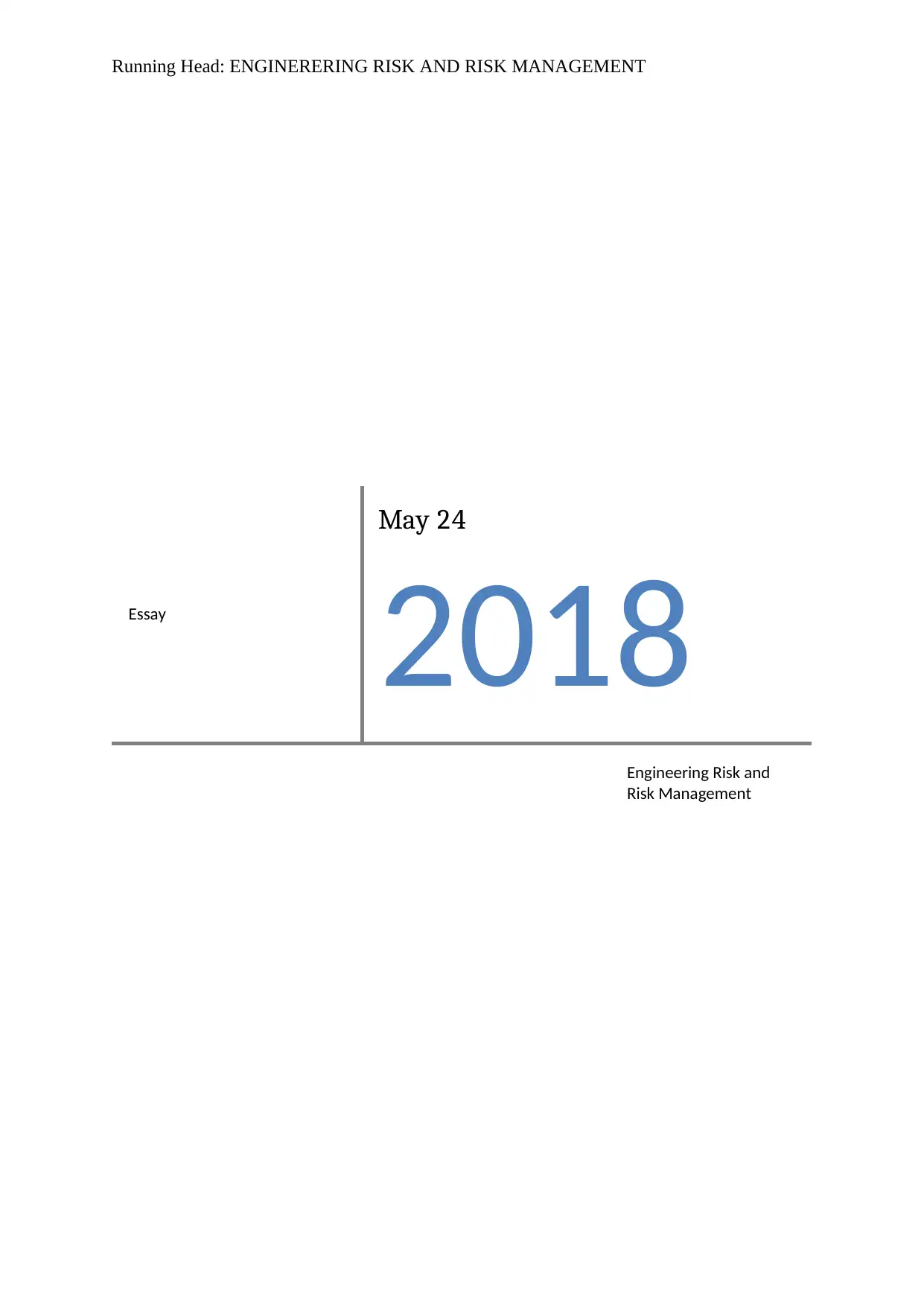
Running Head: ENGINERERING RISK AND RISK MANAGEMENT
Essay
May 24
2018
Engineering Risk and
Risk Management
Essay
May 24
2018
Engineering Risk and
Risk Management
Paraphrase This Document
Need a fresh take? Get an instant paraphrase of this document with our AI Paraphraser
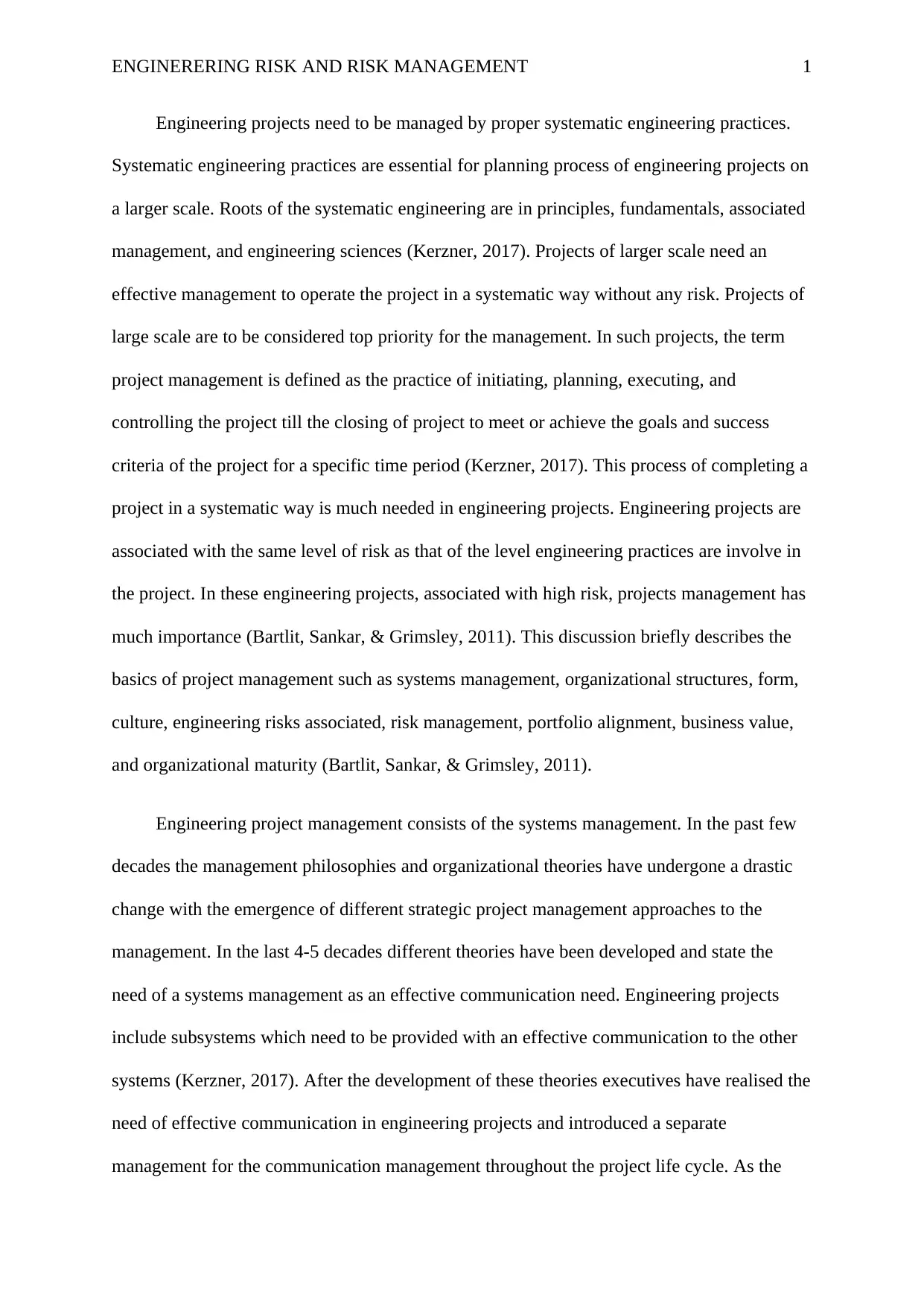
ENGINERERING RISK AND RISK MANAGEMENT 1
Engineering projects need to be managed by proper systematic engineering practices.
Systematic engineering practices are essential for planning process of engineering projects on
a larger scale. Roots of the systematic engineering are in principles, fundamentals, associated
management, and engineering sciences (Kerzner, 2017). Projects of larger scale need an
effective management to operate the project in a systematic way without any risk. Projects of
large scale are to be considered top priority for the management. In such projects, the term
project management is defined as the practice of initiating, planning, executing, and
controlling the project till the closing of project to meet or achieve the goals and success
criteria of the project for a specific time period (Kerzner, 2017). This process of completing a
project in a systematic way is much needed in engineering projects. Engineering projects are
associated with the same level of risk as that of the level engineering practices are involve in
the project. In these engineering projects, associated with high risk, projects management has
much importance (Bartlit, Sankar, & Grimsley, 2011). This discussion briefly describes the
basics of project management such as systems management, organizational structures, form,
culture, engineering risks associated, risk management, portfolio alignment, business value,
and organizational maturity (Bartlit, Sankar, & Grimsley, 2011).
Engineering project management consists of the systems management. In the past few
decades the management philosophies and organizational theories have undergone a drastic
change with the emergence of different strategic project management approaches to the
management. In the last 4-5 decades different theories have been developed and state the
need of a systems management as an effective communication need. Engineering projects
include subsystems which need to be provided with an effective communication to the other
systems (Kerzner, 2017). After the development of these theories executives have realised the
need of effective communication in engineering projects and introduced a separate
management for the communication management throughout the project life cycle. As the
Engineering projects need to be managed by proper systematic engineering practices.
Systematic engineering practices are essential for planning process of engineering projects on
a larger scale. Roots of the systematic engineering are in principles, fundamentals, associated
management, and engineering sciences (Kerzner, 2017). Projects of larger scale need an
effective management to operate the project in a systematic way without any risk. Projects of
large scale are to be considered top priority for the management. In such projects, the term
project management is defined as the practice of initiating, planning, executing, and
controlling the project till the closing of project to meet or achieve the goals and success
criteria of the project for a specific time period (Kerzner, 2017). This process of completing a
project in a systematic way is much needed in engineering projects. Engineering projects are
associated with the same level of risk as that of the level engineering practices are involve in
the project. In these engineering projects, associated with high risk, projects management has
much importance (Bartlit, Sankar, & Grimsley, 2011). This discussion briefly describes the
basics of project management such as systems management, organizational structures, form,
culture, engineering risks associated, risk management, portfolio alignment, business value,
and organizational maturity (Bartlit, Sankar, & Grimsley, 2011).
Engineering project management consists of the systems management. In the past few
decades the management philosophies and organizational theories have undergone a drastic
change with the emergence of different strategic project management approaches to the
management. In the last 4-5 decades different theories have been developed and state the
need of a systems management as an effective communication need. Engineering projects
include subsystems which need to be provided with an effective communication to the other
systems (Kerzner, 2017). After the development of these theories executives have realised the
need of effective communication in engineering projects and introduced a separate
management for the communication management throughout the project life cycle. As the
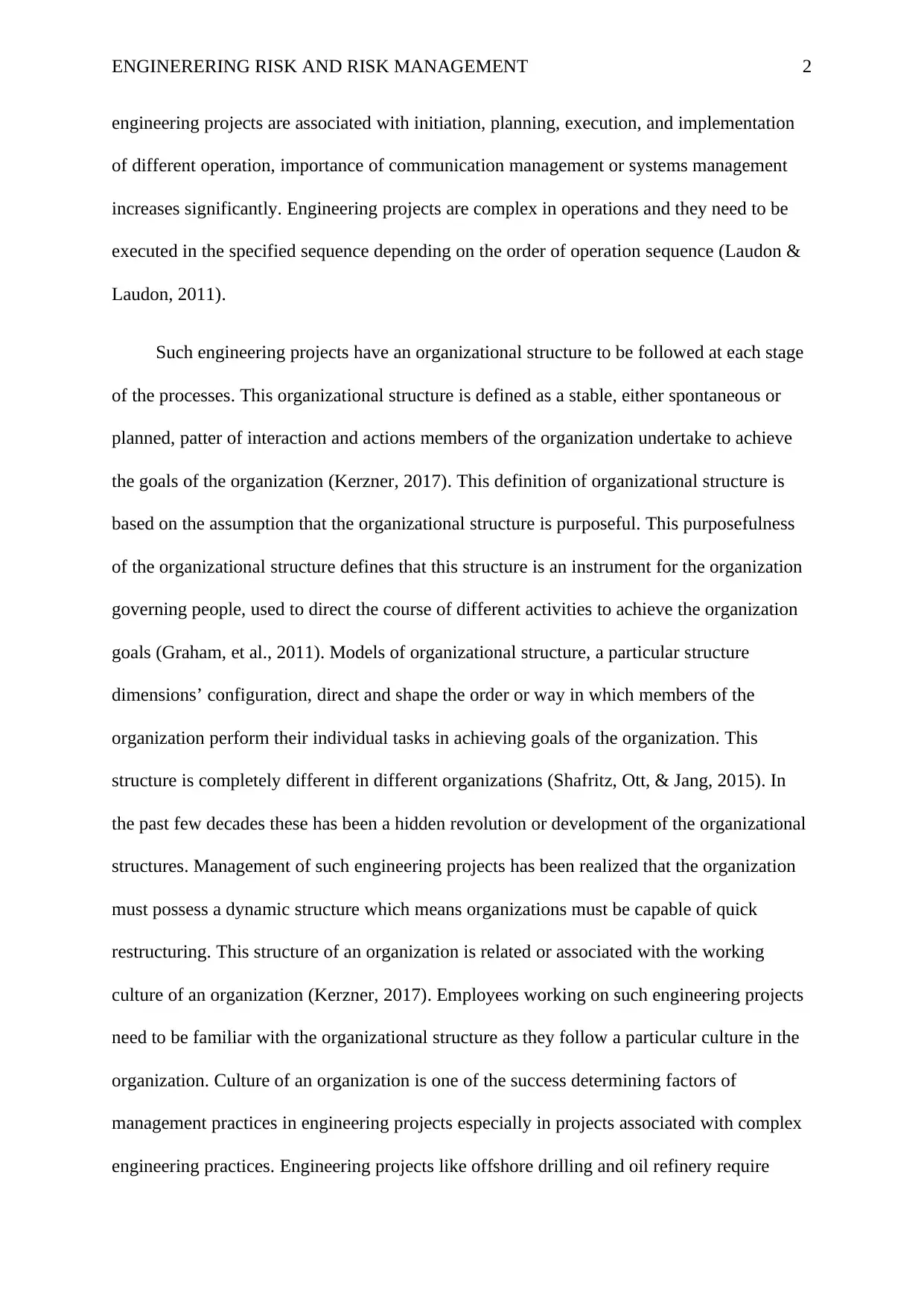
ENGINERERING RISK AND RISK MANAGEMENT 2
engineering projects are associated with initiation, planning, execution, and implementation
of different operation, importance of communication management or systems management
increases significantly. Engineering projects are complex in operations and they need to be
executed in the specified sequence depending on the order of operation sequence (Laudon &
Laudon, 2011).
Such engineering projects have an organizational structure to be followed at each stage
of the processes. This organizational structure is defined as a stable, either spontaneous or
planned, patter of interaction and actions members of the organization undertake to achieve
the goals of the organization (Kerzner, 2017). This definition of organizational structure is
based on the assumption that the organizational structure is purposeful. This purposefulness
of the organizational structure defines that this structure is an instrument for the organization
governing people, used to direct the course of different activities to achieve the organization
goals (Graham, et al., 2011). Models of organizational structure, a particular structure
dimensions’ configuration, direct and shape the order or way in which members of the
organization perform their individual tasks in achieving goals of the organization. This
structure is completely different in different organizations (Shafritz, Ott, & Jang, 2015). In
the past few decades these has been a hidden revolution or development of the organizational
structures. Management of such engineering projects has been realized that the organization
must possess a dynamic structure which means organizations must be capable of quick
restructuring. This structure of an organization is related or associated with the working
culture of an organization (Kerzner, 2017). Employees working on such engineering projects
need to be familiar with the organizational structure as they follow a particular culture in the
organization. Culture of an organization is one of the success determining factors of
management practices in engineering projects especially in projects associated with complex
engineering practices. Engineering projects like offshore drilling and oil refinery require
engineering projects are associated with initiation, planning, execution, and implementation
of different operation, importance of communication management or systems management
increases significantly. Engineering projects are complex in operations and they need to be
executed in the specified sequence depending on the order of operation sequence (Laudon &
Laudon, 2011).
Such engineering projects have an organizational structure to be followed at each stage
of the processes. This organizational structure is defined as a stable, either spontaneous or
planned, patter of interaction and actions members of the organization undertake to achieve
the goals of the organization (Kerzner, 2017). This definition of organizational structure is
based on the assumption that the organizational structure is purposeful. This purposefulness
of the organizational structure defines that this structure is an instrument for the organization
governing people, used to direct the course of different activities to achieve the organization
goals (Graham, et al., 2011). Models of organizational structure, a particular structure
dimensions’ configuration, direct and shape the order or way in which members of the
organization perform their individual tasks in achieving goals of the organization. This
structure is completely different in different organizations (Shafritz, Ott, & Jang, 2015). In
the past few decades these has been a hidden revolution or development of the organizational
structures. Management of such engineering projects has been realized that the organization
must possess a dynamic structure which means organizations must be capable of quick
restructuring. This structure of an organization is related or associated with the working
culture of an organization (Kerzner, 2017). Employees working on such engineering projects
need to be familiar with the organizational structure as they follow a particular culture in the
organization. Culture of an organization is one of the success determining factors of
management practices in engineering projects especially in projects associated with complex
engineering practices. Engineering projects like offshore drilling and oil refinery require
⊘ This is a preview!⊘
Do you want full access?
Subscribe today to unlock all pages.

Trusted by 1+ million students worldwide
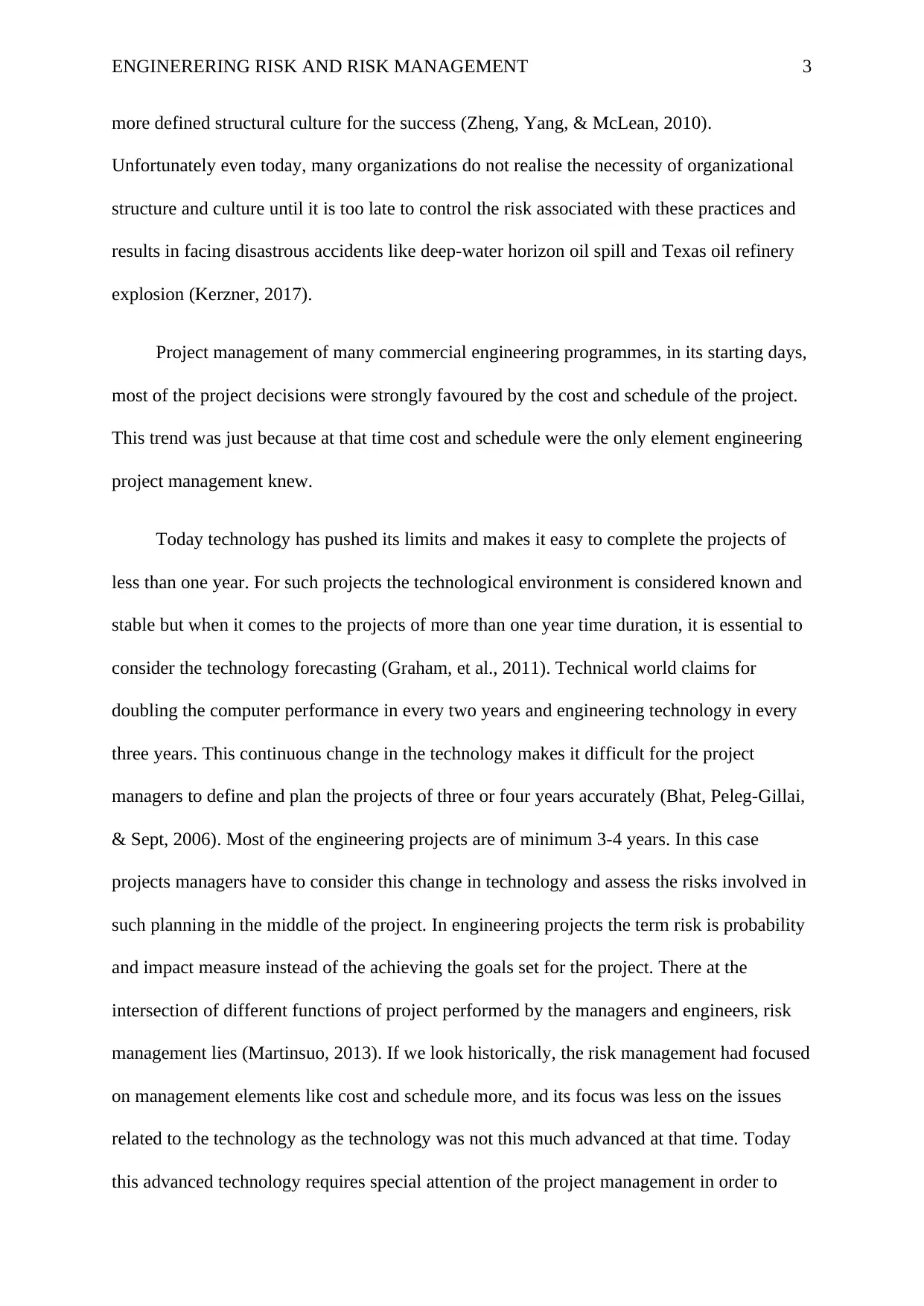
ENGINERERING RISK AND RISK MANAGEMENT 3
more defined structural culture for the success (Zheng, Yang, & McLean, 2010).
Unfortunately even today, many organizations do not realise the necessity of organizational
structure and culture until it is too late to control the risk associated with these practices and
results in facing disastrous accidents like deep-water horizon oil spill and Texas oil refinery
explosion (Kerzner, 2017).
Project management of many commercial engineering programmes, in its starting days,
most of the project decisions were strongly favoured by the cost and schedule of the project.
This trend was just because at that time cost and schedule were the only element engineering
project management knew.
Today technology has pushed its limits and makes it easy to complete the projects of
less than one year. For such projects the technological environment is considered known and
stable but when it comes to the projects of more than one year time duration, it is essential to
consider the technology forecasting (Graham, et al., 2011). Technical world claims for
doubling the computer performance in every two years and engineering technology in every
three years. This continuous change in the technology makes it difficult for the project
managers to define and plan the projects of three or four years accurately (Bhat, Peleg-Gillai,
& Sept, 2006). Most of the engineering projects are of minimum 3-4 years. In this case
projects managers have to consider this change in technology and assess the risks involved in
such planning in the middle of the project. In engineering projects the term risk is probability
and impact measure instead of the achieving the goals set for the project. There at the
intersection of different functions of project performed by the managers and engineers, risk
management lies (Martinsuo, 2013). If we look historically, the risk management had focused
on management elements like cost and schedule more, and its focus was less on the issues
related to the technology as the technology was not this much advanced at that time. Today
this advanced technology requires special attention of the project management in order to
more defined structural culture for the success (Zheng, Yang, & McLean, 2010).
Unfortunately even today, many organizations do not realise the necessity of organizational
structure and culture until it is too late to control the risk associated with these practices and
results in facing disastrous accidents like deep-water horizon oil spill and Texas oil refinery
explosion (Kerzner, 2017).
Project management of many commercial engineering programmes, in its starting days,
most of the project decisions were strongly favoured by the cost and schedule of the project.
This trend was just because at that time cost and schedule were the only element engineering
project management knew.
Today technology has pushed its limits and makes it easy to complete the projects of
less than one year. For such projects the technological environment is considered known and
stable but when it comes to the projects of more than one year time duration, it is essential to
consider the technology forecasting (Graham, et al., 2011). Technical world claims for
doubling the computer performance in every two years and engineering technology in every
three years. This continuous change in the technology makes it difficult for the project
managers to define and plan the projects of three or four years accurately (Bhat, Peleg-Gillai,
& Sept, 2006). Most of the engineering projects are of minimum 3-4 years. In this case
projects managers have to consider this change in technology and assess the risks involved in
such planning in the middle of the project. In engineering projects the term risk is probability
and impact measure instead of the achieving the goals set for the project. There at the
intersection of different functions of project performed by the managers and engineers, risk
management lies (Martinsuo, 2013). If we look historically, the risk management had focused
on management elements like cost and schedule more, and its focus was less on the issues
related to the technology as the technology was not this much advanced at that time. Today
this advanced technology requires special attention of the project management in order to
Paraphrase This Document
Need a fresh take? Get an instant paraphrase of this document with our AI Paraphraser
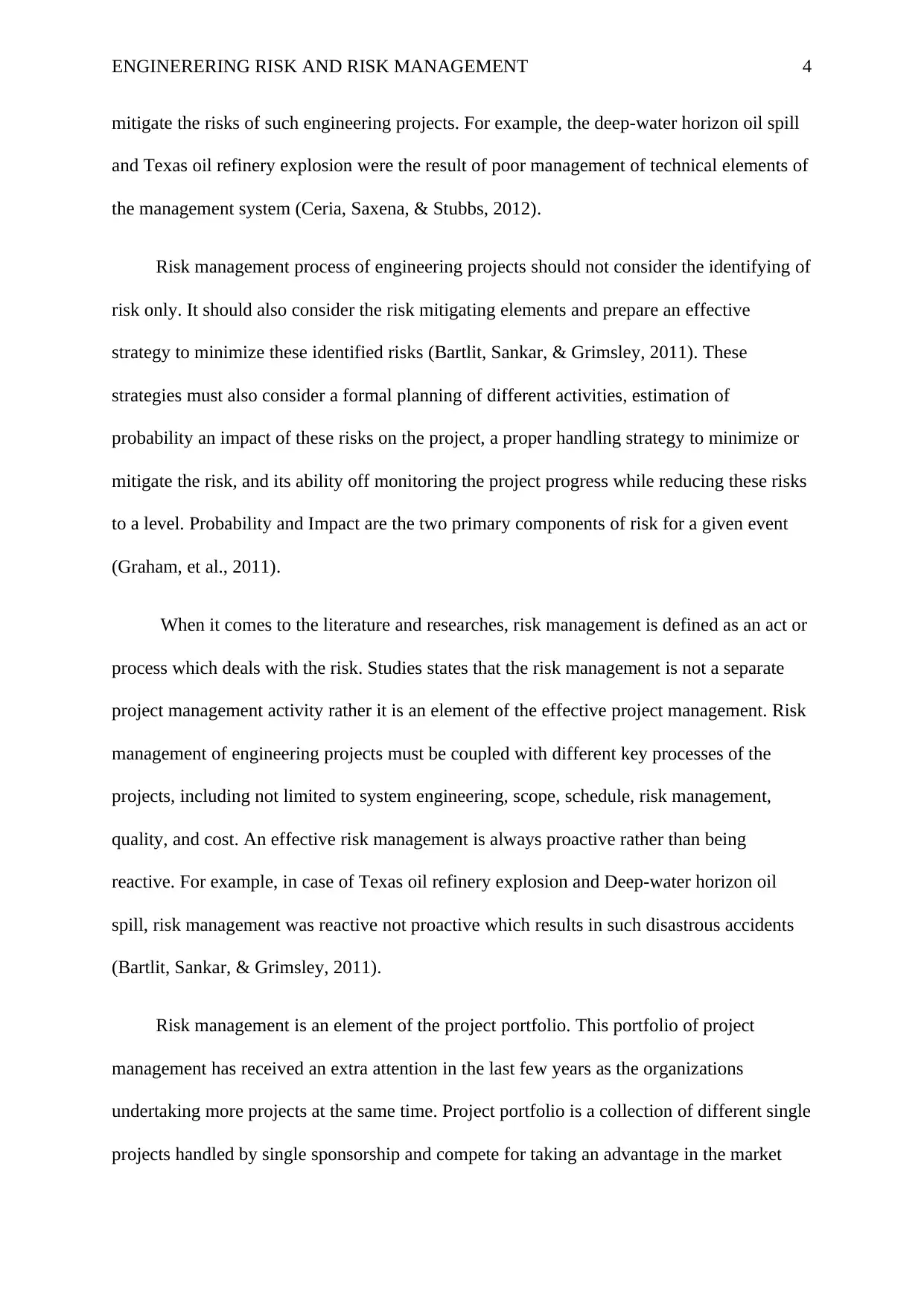
ENGINERERING RISK AND RISK MANAGEMENT 4
mitigate the risks of such engineering projects. For example, the deep-water horizon oil spill
and Texas oil refinery explosion were the result of poor management of technical elements of
the management system (Ceria, Saxena, & Stubbs, 2012).
Risk management process of engineering projects should not consider the identifying of
risk only. It should also consider the risk mitigating elements and prepare an effective
strategy to minimize these identified risks (Bartlit, Sankar, & Grimsley, 2011). These
strategies must also consider a formal planning of different activities, estimation of
probability an impact of these risks on the project, a proper handling strategy to minimize or
mitigate the risk, and its ability off monitoring the project progress while reducing these risks
to a level. Probability and Impact are the two primary components of risk for a given event
(Graham, et al., 2011).
When it comes to the literature and researches, risk management is defined as an act or
process which deals with the risk. Studies states that the risk management is not a separate
project management activity rather it is an element of the effective project management. Risk
management of engineering projects must be coupled with different key processes of the
projects, including not limited to system engineering, scope, schedule, risk management,
quality, and cost. An effective risk management is always proactive rather than being
reactive. For example, in case of Texas oil refinery explosion and Deep-water horizon oil
spill, risk management was reactive not proactive which results in such disastrous accidents
(Bartlit, Sankar, & Grimsley, 2011).
Risk management is an element of the project portfolio. This portfolio of project
management has received an extra attention in the last few years as the organizations
undertaking more projects at the same time. Project portfolio is a collection of different single
projects handled by single sponsorship and compete for taking an advantage in the market
mitigate the risks of such engineering projects. For example, the deep-water horizon oil spill
and Texas oil refinery explosion were the result of poor management of technical elements of
the management system (Ceria, Saxena, & Stubbs, 2012).
Risk management process of engineering projects should not consider the identifying of
risk only. It should also consider the risk mitigating elements and prepare an effective
strategy to minimize these identified risks (Bartlit, Sankar, & Grimsley, 2011). These
strategies must also consider a formal planning of different activities, estimation of
probability an impact of these risks on the project, a proper handling strategy to minimize or
mitigate the risk, and its ability off monitoring the project progress while reducing these risks
to a level. Probability and Impact are the two primary components of risk for a given event
(Graham, et al., 2011).
When it comes to the literature and researches, risk management is defined as an act or
process which deals with the risk. Studies states that the risk management is not a separate
project management activity rather it is an element of the effective project management. Risk
management of engineering projects must be coupled with different key processes of the
projects, including not limited to system engineering, scope, schedule, risk management,
quality, and cost. An effective risk management is always proactive rather than being
reactive. For example, in case of Texas oil refinery explosion and Deep-water horizon oil
spill, risk management was reactive not proactive which results in such disastrous accidents
(Bartlit, Sankar, & Grimsley, 2011).
Risk management is an element of the project portfolio. This portfolio of project
management has received an extra attention in the last few years as the organizations
undertaking more projects at the same time. Project portfolio is a collection of different single
projects handled by single sponsorship and compete for taking an advantage in the market
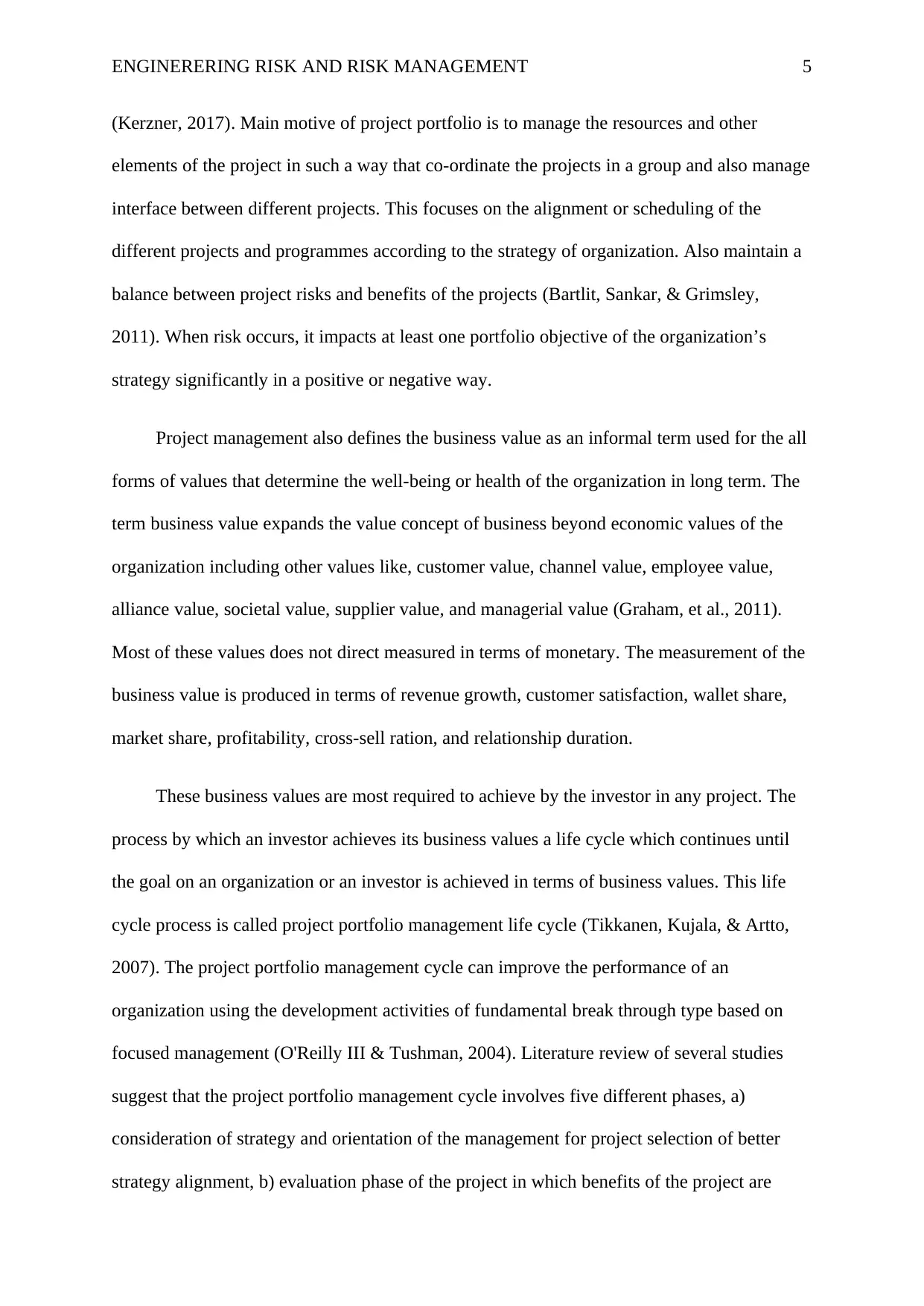
ENGINERERING RISK AND RISK MANAGEMENT 5
(Kerzner, 2017). Main motive of project portfolio is to manage the resources and other
elements of the project in such a way that co-ordinate the projects in a group and also manage
interface between different projects. This focuses on the alignment or scheduling of the
different projects and programmes according to the strategy of organization. Also maintain a
balance between project risks and benefits of the projects (Bartlit, Sankar, & Grimsley,
2011). When risk occurs, it impacts at least one portfolio objective of the organization’s
strategy significantly in a positive or negative way.
Project management also defines the business value as an informal term used for the all
forms of values that determine the well-being or health of the organization in long term. The
term business value expands the value concept of business beyond economic values of the
organization including other values like, customer value, channel value, employee value,
alliance value, societal value, supplier value, and managerial value (Graham, et al., 2011).
Most of these values does not direct measured in terms of monetary. The measurement of the
business value is produced in terms of revenue growth, customer satisfaction, wallet share,
market share, profitability, cross-sell ration, and relationship duration.
These business values are most required to achieve by the investor in any project. The
process by which an investor achieves its business values a life cycle which continues until
the goal on an organization or an investor is achieved in terms of business values. This life
cycle process is called project portfolio management life cycle (Tikkanen, Kujala, & Artto,
2007). The project portfolio management cycle can improve the performance of an
organization using the development activities of fundamental break through type based on
focused management (O'Reilly III & Tushman, 2004). Literature review of several studies
suggest that the project portfolio management cycle involves five different phases, a)
consideration of strategy and orientation of the management for project selection of better
strategy alignment, b) evaluation phase of the project in which benefits of the project are
(Kerzner, 2017). Main motive of project portfolio is to manage the resources and other
elements of the project in such a way that co-ordinate the projects in a group and also manage
interface between different projects. This focuses on the alignment or scheduling of the
different projects and programmes according to the strategy of organization. Also maintain a
balance between project risks and benefits of the projects (Bartlit, Sankar, & Grimsley,
2011). When risk occurs, it impacts at least one portfolio objective of the organization’s
strategy significantly in a positive or negative way.
Project management also defines the business value as an informal term used for the all
forms of values that determine the well-being or health of the organization in long term. The
term business value expands the value concept of business beyond economic values of the
organization including other values like, customer value, channel value, employee value,
alliance value, societal value, supplier value, and managerial value (Graham, et al., 2011).
Most of these values does not direct measured in terms of monetary. The measurement of the
business value is produced in terms of revenue growth, customer satisfaction, wallet share,
market share, profitability, cross-sell ration, and relationship duration.
These business values are most required to achieve by the investor in any project. The
process by which an investor achieves its business values a life cycle which continues until
the goal on an organization or an investor is achieved in terms of business values. This life
cycle process is called project portfolio management life cycle (Tikkanen, Kujala, & Artto,
2007). The project portfolio management cycle can improve the performance of an
organization using the development activities of fundamental break through type based on
focused management (O'Reilly III & Tushman, 2004). Literature review of several studies
suggest that the project portfolio management cycle involves five different phases, a)
consideration of strategy and orientation of the management for project selection of better
strategy alignment, b) evaluation phase of the project in which benefits of the project are
⊘ This is a preview!⊘
Do you want full access?
Subscribe today to unlock all pages.

Trusted by 1+ million students worldwide
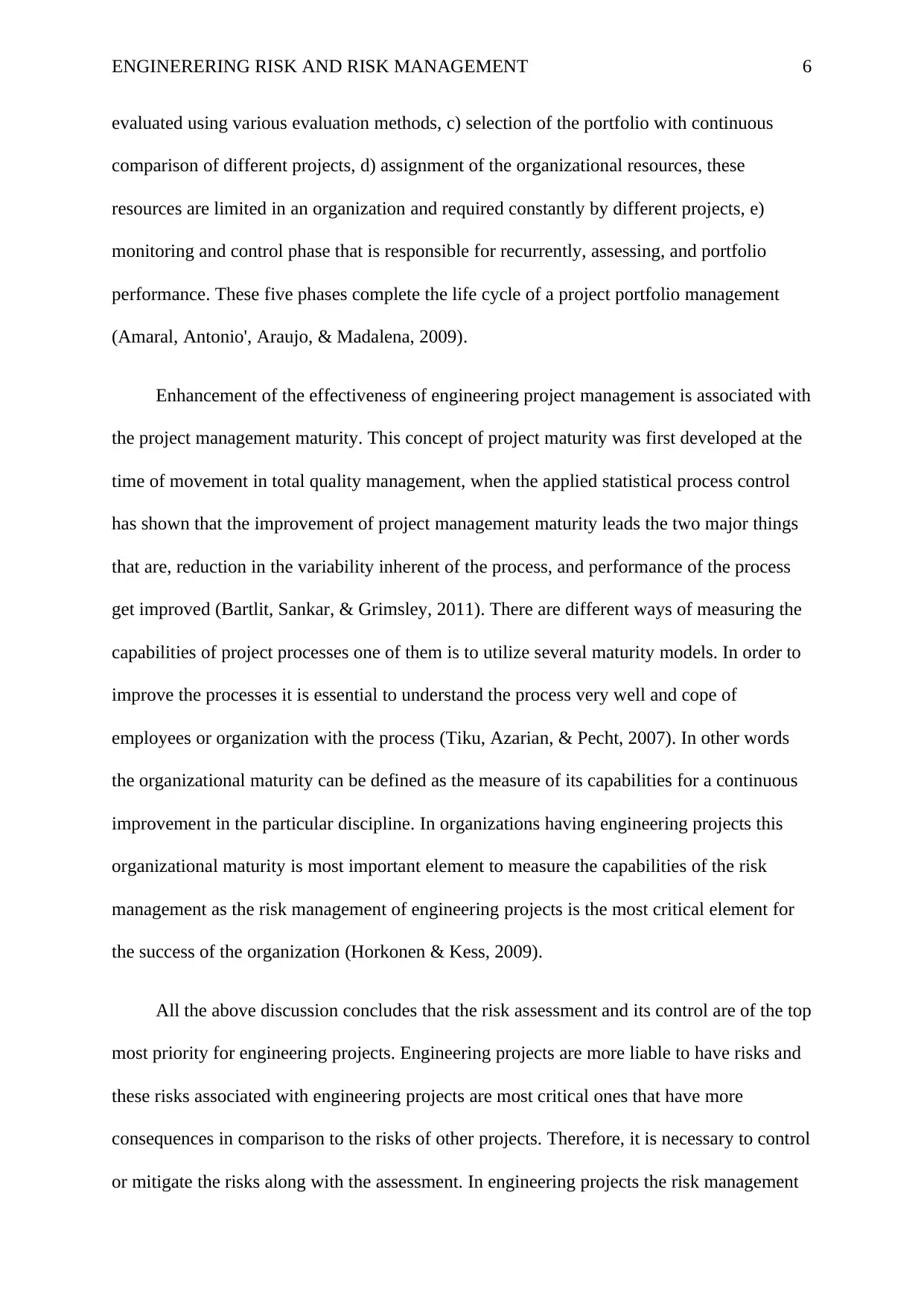
ENGINERERING RISK AND RISK MANAGEMENT 6
evaluated using various evaluation methods, c) selection of the portfolio with continuous
comparison of different projects, d) assignment of the organizational resources, these
resources are limited in an organization and required constantly by different projects, e)
monitoring and control phase that is responsible for recurrently, assessing, and portfolio
performance. These five phases complete the life cycle of a project portfolio management
(Amaral, Antonio', Araujo, & Madalena, 2009).
Enhancement of the effectiveness of engineering project management is associated with
the project management maturity. This concept of project maturity was first developed at the
time of movement in total quality management, when the applied statistical process control
has shown that the improvement of project management maturity leads the two major things
that are, reduction in the variability inherent of the process, and performance of the process
get improved (Bartlit, Sankar, & Grimsley, 2011). There are different ways of measuring the
capabilities of project processes one of them is to utilize several maturity models. In order to
improve the processes it is essential to understand the process very well and cope of
employees or organization with the process (Tiku, Azarian, & Pecht, 2007). In other words
the organizational maturity can be defined as the measure of its capabilities for a continuous
improvement in the particular discipline. In organizations having engineering projects this
organizational maturity is most important element to measure the capabilities of the risk
management as the risk management of engineering projects is the most critical element for
the success of the organization (Horkonen & Kess, 2009).
All the above discussion concludes that the risk assessment and its control are of the top
most priority for engineering projects. Engineering projects are more liable to have risks and
these risks associated with engineering projects are most critical ones that have more
consequences in comparison to the risks of other projects. Therefore, it is necessary to control
or mitigate the risks along with the assessment. In engineering projects the risk management
evaluated using various evaluation methods, c) selection of the portfolio with continuous
comparison of different projects, d) assignment of the organizational resources, these
resources are limited in an organization and required constantly by different projects, e)
monitoring and control phase that is responsible for recurrently, assessing, and portfolio
performance. These five phases complete the life cycle of a project portfolio management
(Amaral, Antonio', Araujo, & Madalena, 2009).
Enhancement of the effectiveness of engineering project management is associated with
the project management maturity. This concept of project maturity was first developed at the
time of movement in total quality management, when the applied statistical process control
has shown that the improvement of project management maturity leads the two major things
that are, reduction in the variability inherent of the process, and performance of the process
get improved (Bartlit, Sankar, & Grimsley, 2011). There are different ways of measuring the
capabilities of project processes one of them is to utilize several maturity models. In order to
improve the processes it is essential to understand the process very well and cope of
employees or organization with the process (Tiku, Azarian, & Pecht, 2007). In other words
the organizational maturity can be defined as the measure of its capabilities for a continuous
improvement in the particular discipline. In organizations having engineering projects this
organizational maturity is most important element to measure the capabilities of the risk
management as the risk management of engineering projects is the most critical element for
the success of the organization (Horkonen & Kess, 2009).
All the above discussion concludes that the risk assessment and its control are of the top
most priority for engineering projects. Engineering projects are more liable to have risks and
these risks associated with engineering projects are most critical ones that have more
consequences in comparison to the risks of other projects. Therefore, it is necessary to control
or mitigate the risks along with the assessment. In engineering projects the risk management
Paraphrase This Document
Need a fresh take? Get an instant paraphrase of this document with our AI Paraphraser
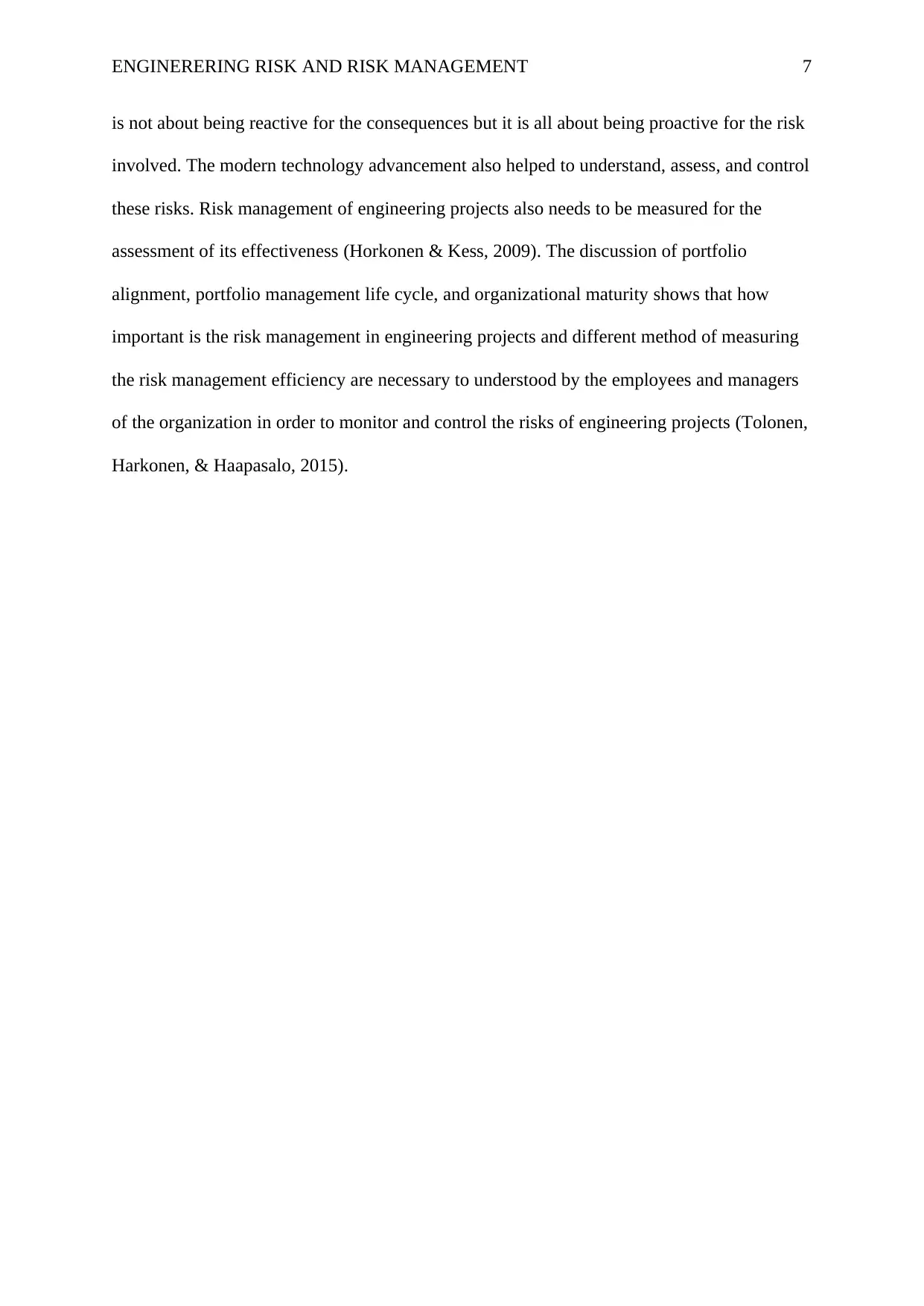
ENGINERERING RISK AND RISK MANAGEMENT 7
is not about being reactive for the consequences but it is all about being proactive for the risk
involved. The modern technology advancement also helped to understand, assess, and control
these risks. Risk management of engineering projects also needs to be measured for the
assessment of its effectiveness (Horkonen & Kess, 2009). The discussion of portfolio
alignment, portfolio management life cycle, and organizational maturity shows that how
important is the risk management in engineering projects and different method of measuring
the risk management efficiency are necessary to understood by the employees and managers
of the organization in order to monitor and control the risks of engineering projects (Tolonen,
Harkonen, & Haapasalo, 2015).
is not about being reactive for the consequences but it is all about being proactive for the risk
involved. The modern technology advancement also helped to understand, assess, and control
these risks. Risk management of engineering projects also needs to be measured for the
assessment of its effectiveness (Horkonen & Kess, 2009). The discussion of portfolio
alignment, portfolio management life cycle, and organizational maturity shows that how
important is the risk management in engineering projects and different method of measuring
the risk management efficiency are necessary to understood by the employees and managers
of the organization in order to monitor and control the risks of engineering projects (Tolonen,
Harkonen, & Haapasalo, 2015).
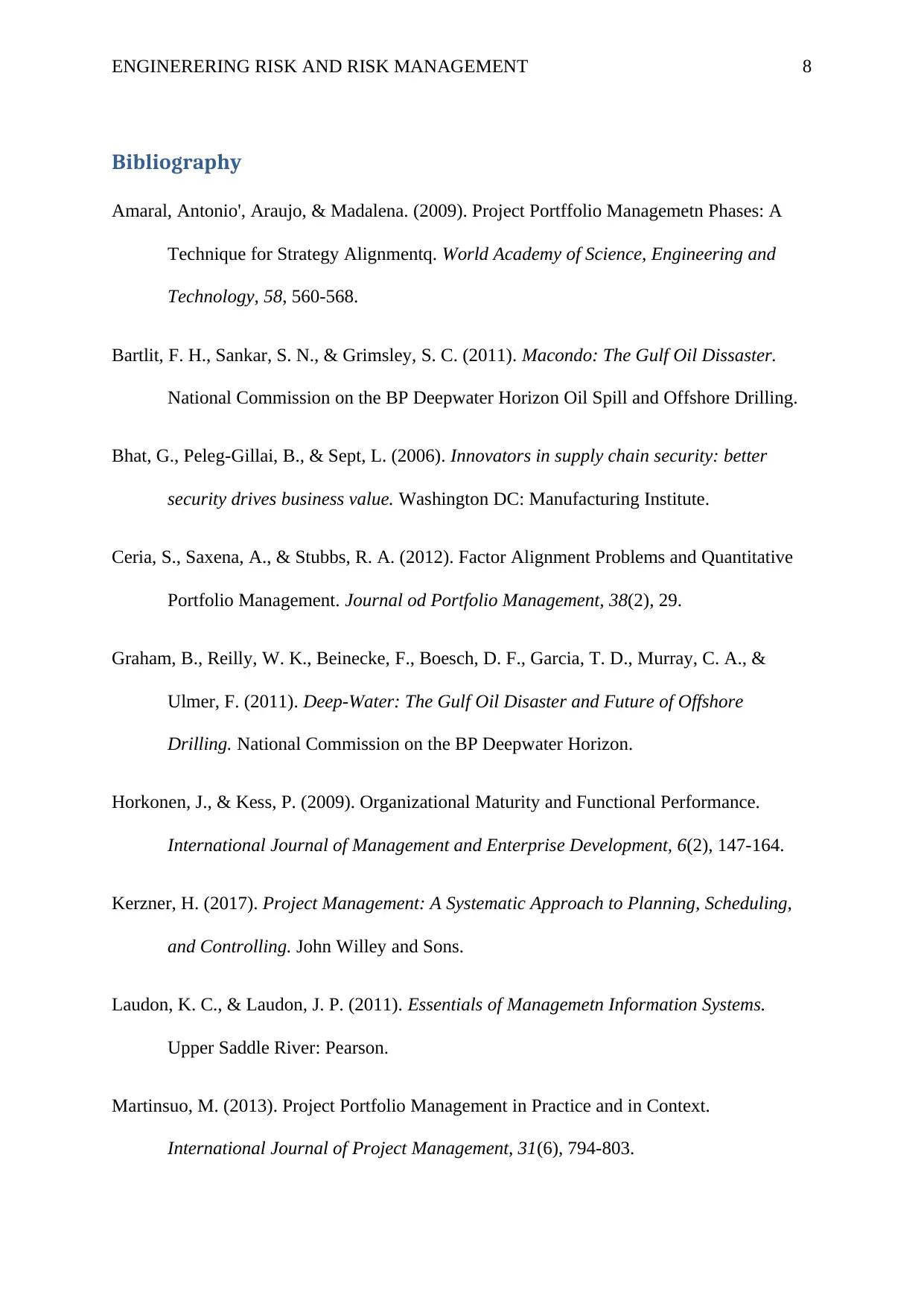
ENGINERERING RISK AND RISK MANAGEMENT 8
Bibliography
Amaral, Antonio', Araujo, & Madalena. (2009). Project Portffolio Managemetn Phases: A
Technique for Strategy Alignmentq. World Academy of Science, Engineering and
Technology, 58, 560-568.
Bartlit, F. H., Sankar, S. N., & Grimsley, S. C. (2011). Macondo: The Gulf Oil Dissaster.
National Commission on the BP Deepwater Horizon Oil Spill and Offshore Drilling.
Bhat, G., Peleg-Gillai, B., & Sept, L. (2006). Innovators in supply chain security: better
security drives business value. Washington DC: Manufacturing Institute.
Ceria, S., Saxena, A., & Stubbs, R. A. (2012). Factor Alignment Problems and Quantitative
Portfolio Management. Journal od Portfolio Management, 38(2), 29.
Graham, B., Reilly, W. K., Beinecke, F., Boesch, D. F., Garcia, T. D., Murray, C. A., &
Ulmer, F. (2011). Deep-Water: The Gulf Oil Disaster and Future of Offshore
Drilling. National Commission on the BP Deepwater Horizon.
Horkonen, J., & Kess, P. (2009). Organizational Maturity and Functional Performance.
International Journal of Management and Enterprise Development, 6(2), 147-164.
Kerzner, H. (2017). Project Management: A Systematic Approach to Planning, Scheduling,
and Controlling. John Willey and Sons.
Laudon, K. C., & Laudon, J. P. (2011). Essentials of Managemetn Information Systems.
Upper Saddle River: Pearson.
Martinsuo, M. (2013). Project Portfolio Management in Practice and in Context.
International Journal of Project Management, 31(6), 794-803.
Bibliography
Amaral, Antonio', Araujo, & Madalena. (2009). Project Portffolio Managemetn Phases: A
Technique for Strategy Alignmentq. World Academy of Science, Engineering and
Technology, 58, 560-568.
Bartlit, F. H., Sankar, S. N., & Grimsley, S. C. (2011). Macondo: The Gulf Oil Dissaster.
National Commission on the BP Deepwater Horizon Oil Spill and Offshore Drilling.
Bhat, G., Peleg-Gillai, B., & Sept, L. (2006). Innovators in supply chain security: better
security drives business value. Washington DC: Manufacturing Institute.
Ceria, S., Saxena, A., & Stubbs, R. A. (2012). Factor Alignment Problems and Quantitative
Portfolio Management. Journal od Portfolio Management, 38(2), 29.
Graham, B., Reilly, W. K., Beinecke, F., Boesch, D. F., Garcia, T. D., Murray, C. A., &
Ulmer, F. (2011). Deep-Water: The Gulf Oil Disaster and Future of Offshore
Drilling. National Commission on the BP Deepwater Horizon.
Horkonen, J., & Kess, P. (2009). Organizational Maturity and Functional Performance.
International Journal of Management and Enterprise Development, 6(2), 147-164.
Kerzner, H. (2017). Project Management: A Systematic Approach to Planning, Scheduling,
and Controlling. John Willey and Sons.
Laudon, K. C., & Laudon, J. P. (2011). Essentials of Managemetn Information Systems.
Upper Saddle River: Pearson.
Martinsuo, M. (2013). Project Portfolio Management in Practice and in Context.
International Journal of Project Management, 31(6), 794-803.
⊘ This is a preview!⊘
Do you want full access?
Subscribe today to unlock all pages.

Trusted by 1+ million students worldwide
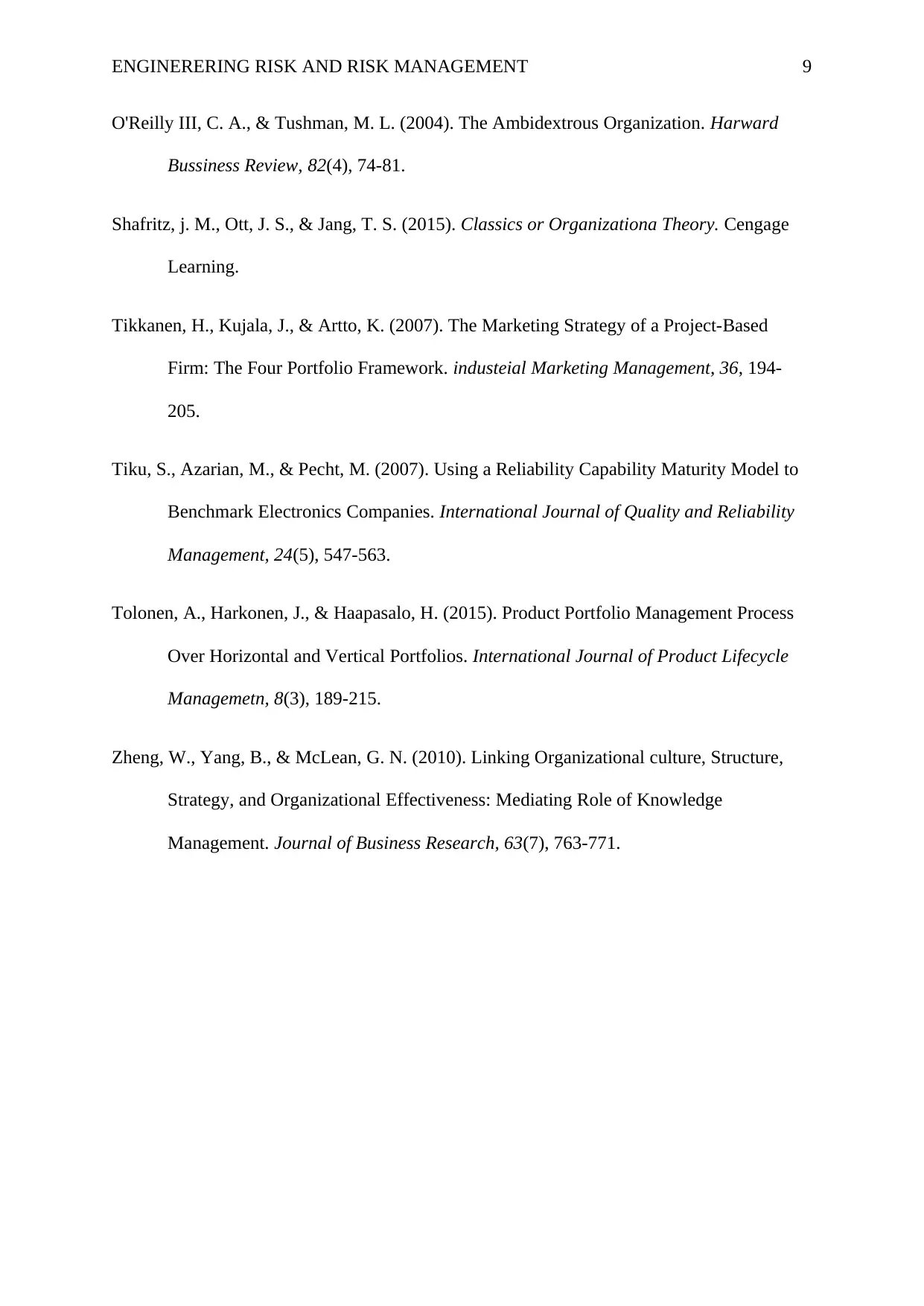
ENGINERERING RISK AND RISK MANAGEMENT 9
O'Reilly III, C. A., & Tushman, M. L. (2004). The Ambidextrous Organization. Harward
Bussiness Review, 82(4), 74-81.
Shafritz, j. M., Ott, J. S., & Jang, T. S. (2015). Classics or Organizationa Theory. Cengage
Learning.
Tikkanen, H., Kujala, J., & Artto, K. (2007). The Marketing Strategy of a Project-Based
Firm: The Four Portfolio Framework. industeial Marketing Management, 36, 194-
205.
Tiku, S., Azarian, M., & Pecht, M. (2007). Using a Reliability Capability Maturity Model to
Benchmark Electronics Companies. International Journal of Quality and Reliability
Management, 24(5), 547-563.
Tolonen, A., Harkonen, J., & Haapasalo, H. (2015). Product Portfolio Management Process
Over Horizontal and Vertical Portfolios. International Journal of Product Lifecycle
Managemetn, 8(3), 189-215.
Zheng, W., Yang, B., & McLean, G. N. (2010). Linking Organizational culture, Structure,
Strategy, and Organizational Effectiveness: Mediating Role of Knowledge
Management. Journal of Business Research, 63(7), 763-771.
O'Reilly III, C. A., & Tushman, M. L. (2004). The Ambidextrous Organization. Harward
Bussiness Review, 82(4), 74-81.
Shafritz, j. M., Ott, J. S., & Jang, T. S. (2015). Classics or Organizationa Theory. Cengage
Learning.
Tikkanen, H., Kujala, J., & Artto, K. (2007). The Marketing Strategy of a Project-Based
Firm: The Four Portfolio Framework. industeial Marketing Management, 36, 194-
205.
Tiku, S., Azarian, M., & Pecht, M. (2007). Using a Reliability Capability Maturity Model to
Benchmark Electronics Companies. International Journal of Quality and Reliability
Management, 24(5), 547-563.
Tolonen, A., Harkonen, J., & Haapasalo, H. (2015). Product Portfolio Management Process
Over Horizontal and Vertical Portfolios. International Journal of Product Lifecycle
Managemetn, 8(3), 189-215.
Zheng, W., Yang, B., & McLean, G. N. (2010). Linking Organizational culture, Structure,
Strategy, and Organizational Effectiveness: Mediating Role of Knowledge
Management. Journal of Business Research, 63(7), 763-771.
1 out of 10
Related Documents
Your All-in-One AI-Powered Toolkit for Academic Success.
+13062052269
info@desklib.com
Available 24*7 on WhatsApp / Email
![[object Object]](/_next/static/media/star-bottom.7253800d.svg)
Unlock your academic potential
Copyright © 2020–2025 A2Z Services. All Rights Reserved. Developed and managed by ZUCOL.





